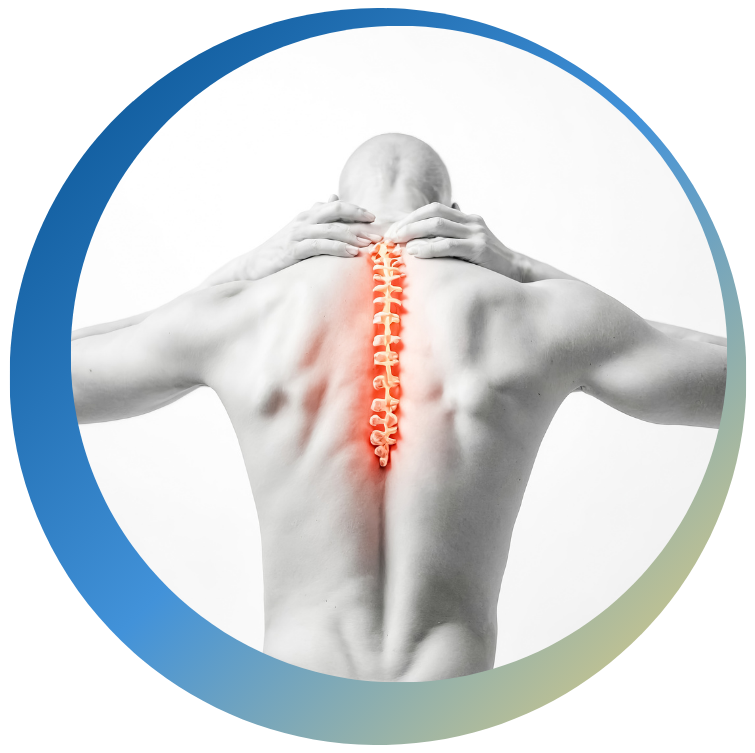

It is estimated that ninety percent of people will suffer from back pain at some time during their life. Usually, these episodes of back pain are self-limited and resolve within one to two weeks of onset. People with persistent low back pain are a small percentage of the population. The personal, economic, social and functional impact of persistent low back pain can be substantial.
The common causes of low back pain include trauma, ageing, degeneration, and fractures. The specific anatomic causes of low back pain include muscles, tendons, ligaments, joints, including the facet joints and intervertebral discs, the nerve roots, sacroiliac joints, bursa, and tailbone. The disc can become affected by disc herniations, disc protrusions, disc bulges, or disc extrusions.
There have been many studies which have recently helped us to better understand the common causes of low back pain. Many of these causes have been elucidated by diagnostic precise spinal injections, specifically blocking nerves that go to the joints, muscles, tendons, ligaments, discs, and nerves to enable diagnosis of the causes of low back pain. Until recently, many people have suffered with low back pain without a clear diagnosis for their low back pain. Doctors have diagnosed their pain as “low back pain”. While this is a description it does not offer a diagnosis or specific cause. Accurate diagnosis helps us to better understand the causes of low back pain and eventually treat these specific causes.
Diagnostic tests that are used to help us better understand low back pain including MRI scans, radiographs (x-rays), EMG nerve conduction studies, CT scans, diagnostic injections, myelograms, CT myelograms.
Structures that cause low back pain include facet joints, discs, nerve roots, muscles, tendons, ligaments, soft tissues, sacroiliac joint, and the coccyx. There can be other anatomic structures that are confused with low back pain, including the hip joint, and this must be ruled out as well as a cause of the low back pain.

Facet joint or zygapophysial joints have been implicated as the source of chronic neck pain anywhere from 39 to 67% of patients who suffer from chronic neck pain. This was substantiated by the International Association for the Study of Pain. The cervical facet joints have significant and abundant nerve supply with pain receptors and the pain can be referred to the back of the head, neck, shoulders and upper arms.
The gold standard for diagnosis of neck pain secondary to facet joints is by injection of local anesthetic around the nerves that innervate to the facet joints. Despite the recent explosion in popularity of imaging studies such as X-rays, MRI scans and CT scans, facet joint pain doesn’t always show up on these studies. In fact most are not reliable for the diagnosis of facet related pain. MRI’s may or may not show facet joint related pain. The prevalence of neck pain is up to 14% of patients reporting Grade 2 to 4 neck pain, which is defined as high pain and dense intensity with disability. This is long lasting pain that impairs patients’ functions and it’s associated with significant health impacts, social impacts and economic impacts as well.
Based on multiple studies, the facet joints are a significant pain generator for cervical pain, headache pain, shoulder pain and even upper extremity pain.
If the pain is secondary to the facet joints then this can be shown by injecting local anesthetic around the joints. Long lasting pain relief can be obtained by radiofrequency ablation, which is commonly known as burning of the nerves. This gives anywhere from 9 to 18 months of continuous pain relief.
Diagnostic studies that can help to diagnose the site of pain include radiographs (x-rays), MRI scans, CT scans and EMG nerve conduction studies. MRI scans utilize magnetic waves in order to image the body tissues. The imaging provided by MRI is excellent for soft tissues (discs, nerve roots, the bones, soft tissues such as muscles, tendons, bursa and ligaments), while CT scans and x-rays are much better at imaging bones and high density structures. EMG nerve conduction studies help to evaluate the integrity of the nervous system and conduction of both motor and sensory nerves.
Treatments for neck pain include non-steroidal anti-inflammatory medications (NSAIDs), anti-depressant medications (Elavil, trazodone), anti-convulsants (Lyrica, Neurontin), opiate pain medications, physical therapy, chiropractic care, bracing including neck braces, gravity inversion therapy, stretching, manipulation therapy, injection therapy and spine surgery.
Spine surgery should be a last resort and should be embarked on only after conservative therapy has not alleviated the pain. In summary accurate diagnosis is the key to successful therapy with patients suffering from chronic neck pain.

The Silver Creek Pain Relief Center offers a holistic approach to pain management, focusing on the root causes of discomfort in the back, neck, and spine. Our dedicated team understands that each patient's experience with pain is unique, and we tailor our treatment plans to address individual needs effectively.
By combining advanced diagnostic techniques with personalized treatment strategies, we aim to provide lasting relief and improve the overall quality of life for our patients. This includes a variety of therapies, from medication management to interventional procedures, ensuring that every aspect of pain is addressed comprehensively.
Back pain is a prevalent issue affecting millions of individuals, often resulting from various factors such as injury, degeneration, or lifestyle choices. Recognizing the underlying causes is essential for effective treatment and management.
At Silver Creek, we utilize state-of-the-art diagnostic tools, including MRI and CT scans, to pinpoint the source of back pain. Our treatment options range from conservative methods like physical therapy and medication to more advanced interventions such as spinal injections and surgery, all designed to restore function and alleviate discomfort.
Neck pain can stem from numerous conditions, including trauma, degenerative diseases, and muscle strain. Understanding these causes is crucial for developing an effective management plan tailored to each patient's situation.
Our team employs various diagnostic methods to accurately assess neck pain, ensuring that we identify the specific issues affecting the cervical spine. Treatment options may include physical therapy, medication, and minimally invasive procedures, all aimed at reducing pain and enhancing mobility for our patients.
At Silver Creek Pain Relief Center, we prioritize patient-centered care, ensuring that each individual feels supported throughout their treatment journey. Our approach involves active communication, allowing patients to express their concerns and preferences regarding their pain management strategies.
We believe that informed patients are empowered patients. Therefore, we provide comprehensive education about their conditions and treatment options, fostering a collaborative environment where patients can participate in their care decisions confidently.